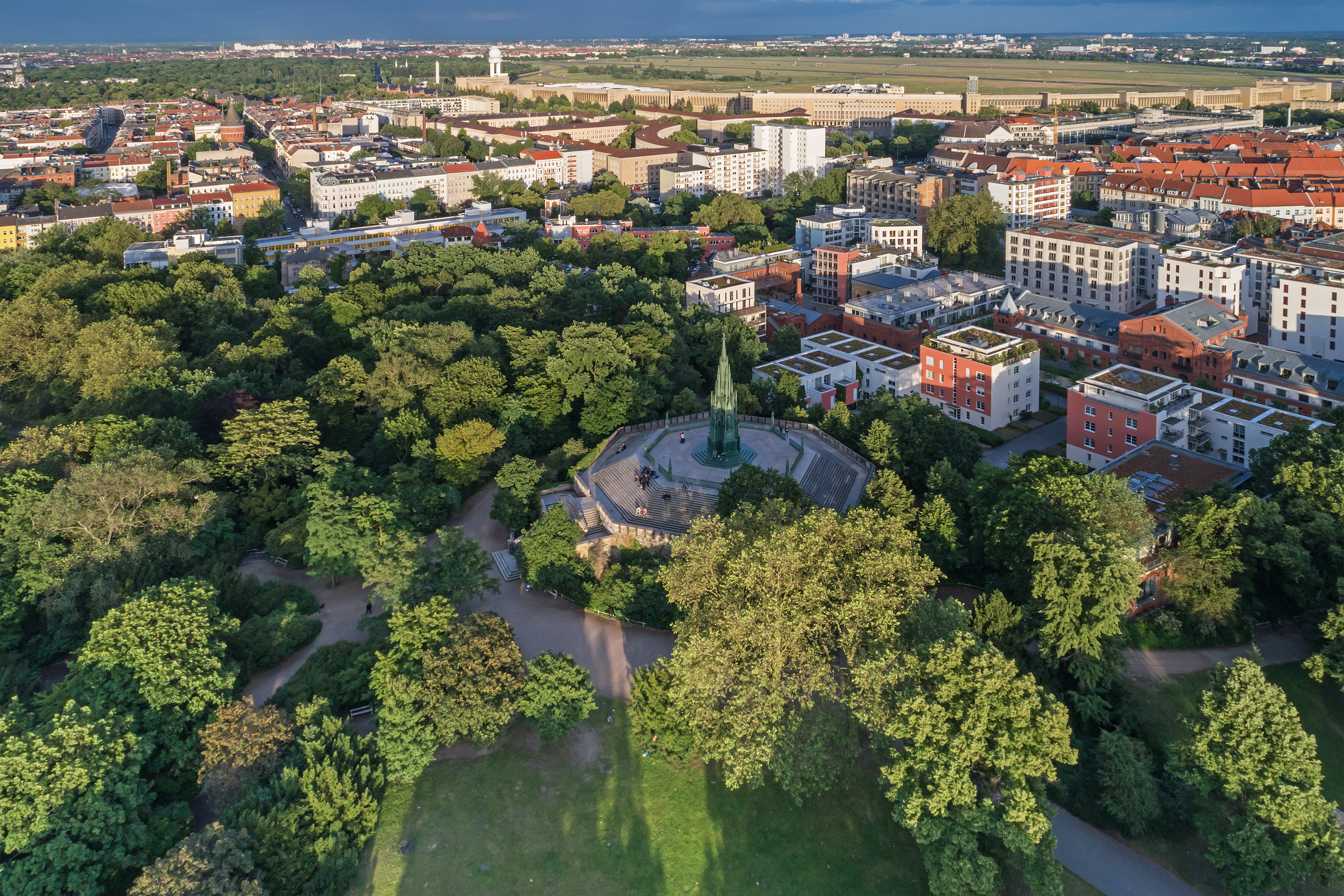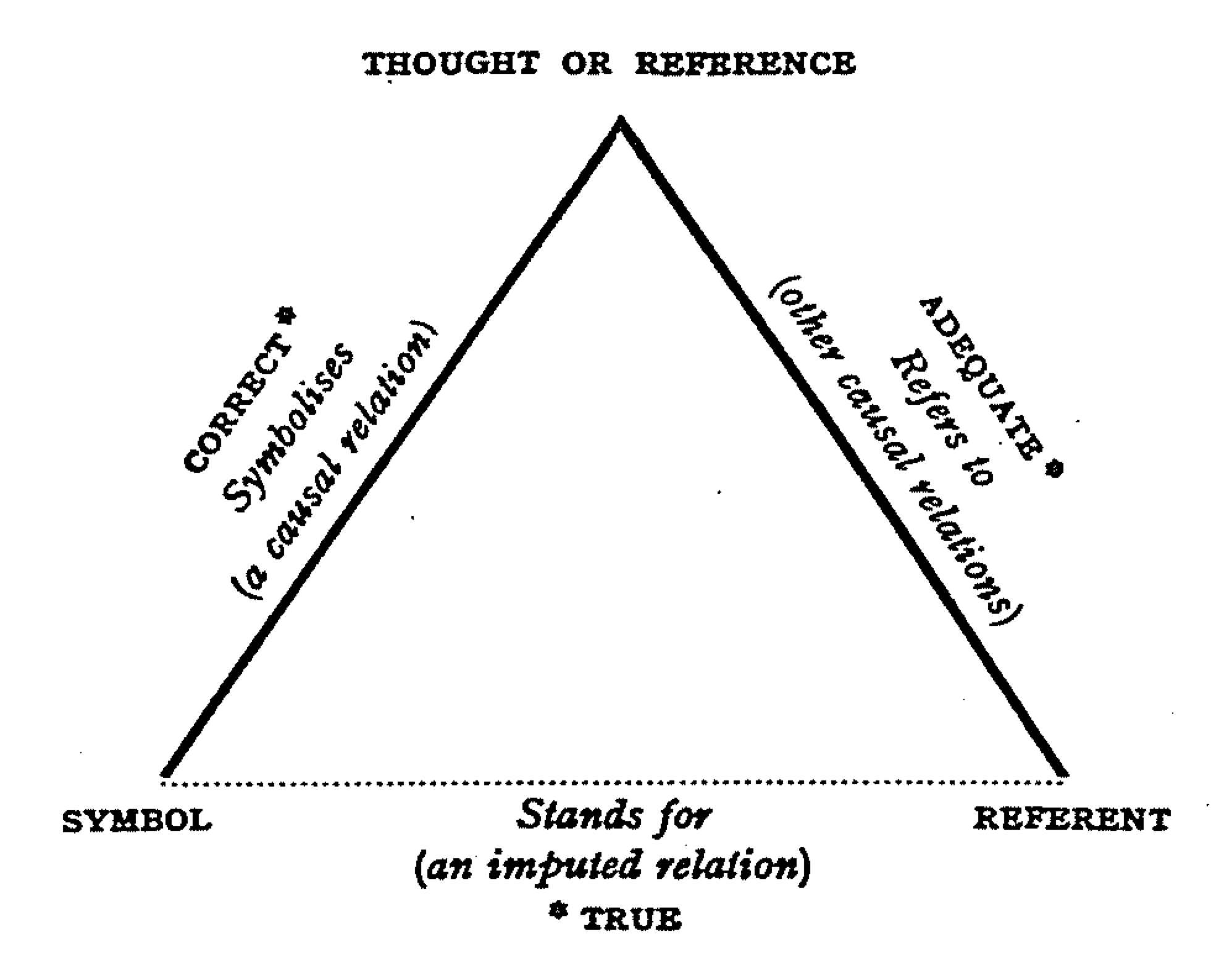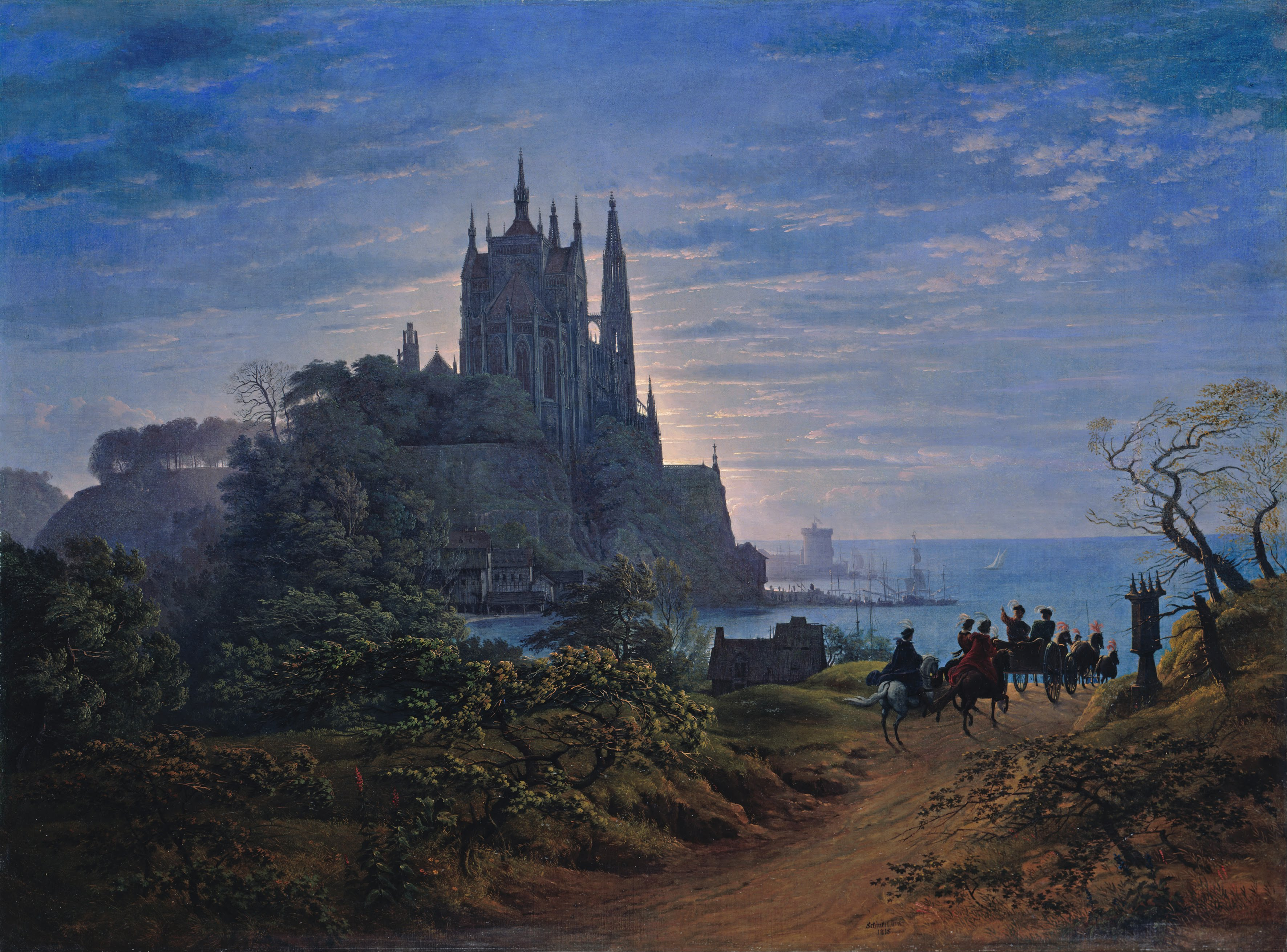|
Viktoriapark (Berlin)
The Viktoriapark ( en, Victoria Park) is an urban park in the locality of Kreuzberg in Berlin, Germany. It opened in 1894. It is situated on the ''Tempelhofer Berge'' range, forming the northern slope of the ground moraine Teltow Plateau, overlooking the glacial valley with Berlin's city centre. The major landmark of the park is a cast iron monument of 1815 dedicated by King Frederick William III of Prussia to the liberation wars (Befreiungskriege) fought at the end of the War of the Sixth coalition against France in the course of the Napoleonic Wars. It provides an excellent viewpoint over much of the central and southern portions of the city. In summer an artificial waterfall originates at the foot of the monument and continues down the hillside to the intersection of Großbeerenstraße and Kreuzbergstraße. A historic wine-growing area, today the park is neighbouring two small vineyards, one in the northeast founded in 1968 and owned by the Senate of Berlin and cu ... [...More Info...] [...Related Items...] OR: [Wikipedia] [Google] [Baidu] |
References
Reference is a relationship between objects in which one object designates, or acts as a means by which to connect to or link to, another object. The first object in this relation is said to ''refer to'' the second object. It is called a '' name'' for the second object. The second object, the one to which the first object refers, is called the '' referent'' of the first object. A name is usually a phrase or expression, or some other symbolic representation. Its referent may be anything – a material object, a person, an event, an activity, or an abstract concept. References can take on many forms, including: a thought, a sensory perception that is audible ( onomatopoeia), visual (text), olfactory, or tactile, emotional state, relationship with other, spacetime coordinate, symbolic or alpha-numeric, a physical object or an energy projection. In some cases, methods are used that intentionally hide the reference from some observers, as in cryptography. References feature in many ... [...More Info...] [...Related Items...] OR: [Wikipedia] [Google] [Baidu] |
Greater Berlin Act
The Greater Berlin Act (german: Groß-Berlin-Gesetz), officially Law Regarding the Creation of the New Municipality of Berlin (german: Gesetz über die Bildung einer neuen Stadtgemeinde Berlin), was a law passed by the Prussian state government in 1920, which greatly expanded the size of the Prussian and German capital of Berlin. History Berlin had been part of the Province of Brandenburg since 1815. On 1 April 1881, the city became Stadtkreis Berlin, a city district separate from Brandenburg. The Greater Berlin Act was passed by the Prussian Parliament on 27 April 1920 and came into effect on 1 October of the same year. The new Prussian province then termed ''Greater Berlin'' acquired territories from the Province of Brandenburg and consisted of the following: * The city of Berlin (''Alt-Berlin''); * 7 towns that surrounded Berlin: Charlottenburg, Köpenick, Lichtenberg, Neukölln/Rixdorf, Schöneberg, Spandau and Wilmersdorf; * 59 rural communities and 27 estate districts ... [...More Info...] [...Related Items...] OR: [Wikipedia] [Google] [Baidu] |
Iron Cross
The Iron Cross (german: link=no, Eisernes Kreuz, , abbreviated EK) was a military decoration in the Kingdom of Prussia, and later in the German Empire (1871–1918) and Nazi Germany (1933–1945). King Frederick William III of Prussia established it on 17 March 1813 during the Napoleonic Wars (EK 1813). The award was backdated to the birthday (10 March) of his late wife, Queen Louise. Louise was the first person to receive this decoration (posthumously). Recommissioned Iron Cross was also awarded during the Franco-Prussian War (EK 1870), World War I (EK 1914), and World War II (EK 1939). During the 1930s and World War II, the Nazi regime superimposed a swastika on the traditional medal. The Iron Cross was usually a military decoration only, though there were instances awarded to civilians for performing military functions, including Hanna Reitsch, who received the Iron Cross, 2nd class, and Iron Cross, 1st Class, and Melitta Schenk Gräfin von Stauffenberg, who recei ... [...More Info...] [...Related Items...] OR: [Wikipedia] [Google] [Baidu] |
Tempelhof
Tempelhof () is a locality of Berlin within the borough of Tempelhof-Schöneberg. It is the location of the former Tempelhof Airport, one of the earliest commercial airports in the world. The former airport and surroundings are now a park called Tempelhofer Feld, making it the largest inner city open space in the world. The Tempelhof locality is located in the south-central part of the city. Before Berlin's 2001 administrative reform, the area of Tempelhof, together with the localities of Mariendorf, Marienfelde, and Lichtenrade, constituted a borough of its own, also called ''Tempelhof''. These localities grew from historic villages on the Teltow plateau founded in the early 13th century in the course of the German Ostsiedlung. History ''Tempelhove'' was first mentioned in a 1247 deed issued at the Walkenried Abbey as a ''Komturhof'' (''commander's court'', the smallest holding entity of a military order) of the Knights Templar, whose leadership and many fellow kni ... [...More Info...] [...Related Items...] OR: [Wikipedia] [Google] [Baidu] |
Karl Friedrich Schinkel
Karl Friedrich Schinkel (13 March 1781 – 9 October 1841) was a Prussian architect, city planner An urban planner (also known as town planner) is a professional who practices in the field of town planning, urban planning or city planning. An urban planner may focus on a specific area of practice and have a title such as city planner, town ... and painter who also designed furniture and stage sets. Schinkel was one of the most prominent architects of Germany and designed both neoclassical and neogothic buildings. His most famous buildings are found in and around Berlin. Biography Schinkel was born in Neuruppin, Margraviate of Brandenburg. When he was six, his father died in the disastrous Neuruppin fire of 1787. He became a student of architect Friedrich Gilly (1772–1800) (the two became close friends) and his father, David Gilly, in Berlin. At that time, the architectural taste in Prussia was shaped in neoclassical style, mainly by Carl Gotthard Langhans, the archit ... [...More Info...] [...Related Items...] OR: [Wikipedia] [Google] [Baidu] |
Prussian National Monument For The Liberation Wars
The Prussian National Monument for the Liberation Wars (german: Preußisches Nationaldenkmal für die Befreiungskriege) is a war memorial in Berlin, Germany, dedicated in 1821. Built by the Prussian king during the sectionalism before the Unification of Germany it is the principal German monument to the Prussian soldiers and other citizens who died in or else dedicated their health and wealth for the Liberation Wars (Befreiungskriege) fought at the end of the Wars of the Sixth and in that of the Seventh Coalition against France in the course of the Napoleonic Wars. Frederick William III of Prussia initiated its construction and commissioned the Prussian Karl Friedrich Schinkel who made it an important piece of art in cast iron, his last piece of Romantic Neo-Gothic architecture and an expression of the post-Napoleonic poverty and material sobriety in the liberated countries.Sibylle Badstübner-Gröger, Michael Bollé, Ralph Paschke et al., ''Handbuch der Deutschen Kunstdenkm ... [...More Info...] [...Related Items...] OR: [Wikipedia] [Google] [Baidu] |
Neoclassical Architecture
Neoclassical architecture is an architectural style produced by the Neoclassical movement that began in the mid-18th century in Italy and France. It became one of the most prominent architectural styles in the Western world. The prevailing styles of architecture in most of Europe for the previous two centuries, Renaissance architecture and Baroque architecture, already represented partial revivals of the Classical architecture of ancient Rome and (much less) ancient Greek architecture, but the Neoclassical movement aimed to strip away the excesses of Late Baroque and return to a purer and more authentic classical style, adapted to modern purposes. The development of archaeology and published accurate records of surviving classical buildings was crucial in the emergence of Neoclassical architecture. In many countries, there was an initial wave essentially drawing on Roman architecture, followed, from about the start of the 19th century, by a second wave of Greek Revival archi ... [...More Info...] [...Related Items...] OR: [Wikipedia] [Google] [Baidu] |
Hintze Kreuzberg 1829
Hintze is a surname. Notable people with the surname include: * Carl Hintze (1851–1916), German mineralogist and crystallographer *Christian Ide Hintze (1953–2012), Austrian poet and performance artist * Johannes Hintze (born 1999), German swimmer * Michael Hintze (born 1953), British-Australian businessman, philanthropist and Conservative Party patron, based in the United Kingdom * Otto Hintze (1861–1940), German historian of public administration * Peter Hintze (1950–2016), German politician of the Christian Democratic Union (CDU) and from 2013 one of the six Vice Presidents of the Bundestag * Paul von Hintze (1864–1941), German naval officer, diplomat and politician See also * Hintze Ribeiro disaster *Christian Hintze Holm (born 1964), Norwegian politician for the Socialist Left Party *Ernesto Hintze Ribeiro Ernesto Rodolfo Hintze Ribeiro (Ponta Delgada, Azores, 7 November 1849 – Lisbon, 1 August 1907) was a Portuguese politician, statesman, and nobleman from the A ... [...More Info...] [...Related Items...] OR: [Wikipedia] [Google] [Baidu] |
Pressed (wine)
In winemaking, pressing is the process where juice is extracted from the grapes with the aid of a wine-press, by hand, or even by the weight of the grape berries and clusters.Jeff Cox ''From Vines to Wines: The Complete Guide to Growing Grapes and Making Your Own Wine'' pgs 131-142 Storey Publishing 1999 Historically, intact grape clusters were trodden by feet but in most wineries today the grapes are sent through a crusher/destemmer, which removes the individual grape berries from the stems and breaks the skins, releasing some juice, prior to being pressed. There are exceptions, such as the case of sparkling wine production in regions such as Champagne where grapes are traditionally whole-cluster pressed with stems included to produce a lighter must that is low in phenolics.J. Robinson (ed) '' The Oxford Companion to Wine'' Third Edition pgs 285-286, 545-546, 767 Oxford University Press 2006 In white wine production, pressing usually takes place immediately after crushing or/a ... [...More Info...] [...Related Items...] OR: [Wikipedia] [Google] [Baidu] |
Bad Bergzabern
Bad Bergzabern () is a municipality in the Südliche Weinstraße district, on the German Wine Route in Rhineland-Palatinate, Germany. It is situated near the border with France, on the south-eastern edge of the Palatinate forest, approximately southwest of Landau. Bad Bergzabern is the seat of the ''Verbandsgemeinde'' ("collective municipality") Bad Bergzabern. Bad Bergzabern has a tradition as a holiday destination and contains various half-timbered houses from the seventeenth and eighteenth centuries. Of particular note from an earlier century is the Gasthaus Zum Engel (1579), which has been described as the most beautiful renaissance building in the entire region. History In the sixteenth century local scholars were keen to assert that the town had been founded under the Romans, and sources from this period refer to the medieval Latin name as ''Tabernae Montanae'' (trans. " taverns of the mountains"). Although the area was indeed under the control of the Roman empire ... [...More Info...] [...Related Items...] OR: [Wikipedia] [Google] [Baidu] |




_-_facade_on_Piazza_dei_signori.jpg)

